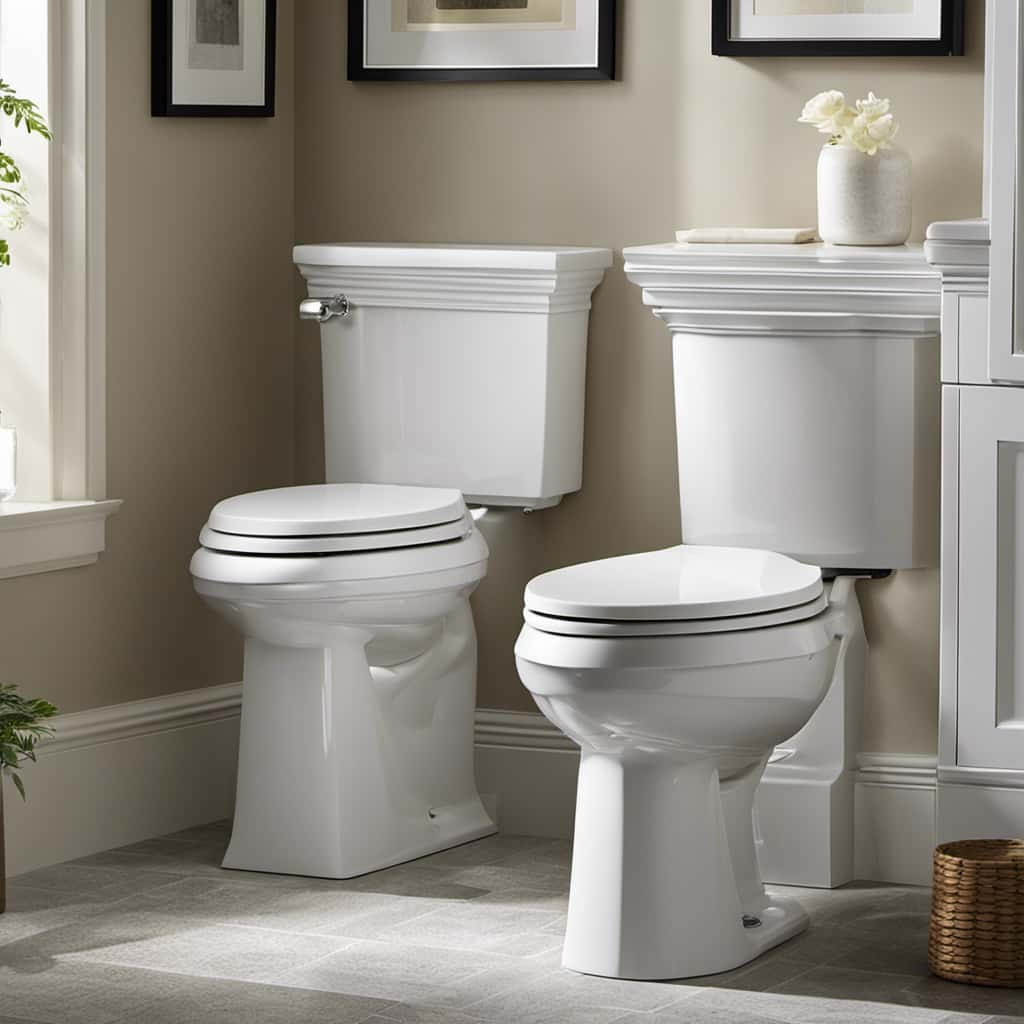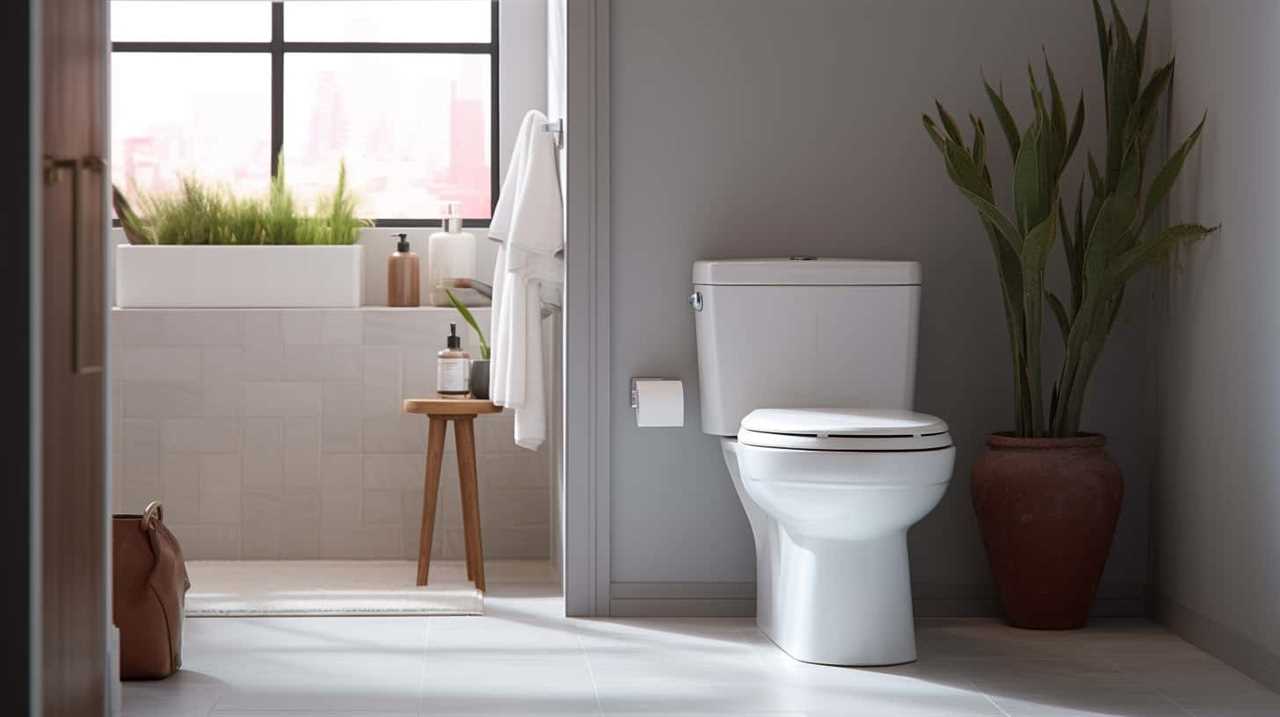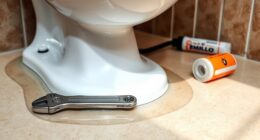Did you know that a wobbly toilet is not only annoying but can also lead to leaks and potential water damage? If you’re tired of the constant rocking and want to fix it yourself, you’re in the right place.
In this article, I’ll guide you through the step-by-step process of identifying the cause of the wobble, gathering the necessary tools, and reinforcing the toilet to ensure it stays stable.
With a little know-how and some basic materials, you’ll have your toilet back to its steady state in no time.
Key Takeaways
- Check for loose bolts or a damaged flange
- Use a wrench and shims to stabilize the toilet
- Level the toilet base and fill any gaps with shims
- Reinforce the toilet flange by tightening bolts and inspecting for damage
Identifying the Cause of the Wobble
To identify the cause of the wobble, you’ll need to check for loose bolts or a damaged flange. Common solutions to fix a wobbly toilet involve tightening the bolts or replacing a damaged flange.
Troubleshooting tips can help you pinpoint the exact issue and resolve it quickly. Start by inspecting the toilet for any visible signs of looseness. If the toilet moves when you apply pressure, it’s likely due to loose bolts. Grab a wrench and tighten them until they are snug.
If the wobbling persists, the flange may be damaged. This is a more complex issue that may require professional help. In such cases, it’s best to consult a plumber who can assess the situation and recommend the appropriate solution.
Gathering the Necessary Tools and Materials
You’ll need a wrench and some shims to stabilize the toilet. When it comes to fixing a wobbly toilet, choosing the right adhesive and ensuring proper alignment are crucial steps.
Firstly, selecting the appropriate adhesive is essential for a long-lasting fix. Look for a strong adhesive that is specifically designed for plumbing repairs. This will ensure that the toilet is securely attached to the floor.
Secondly, ensuring proper alignment is vital to prevent any future wobbling issues. Use the wrench to tighten the bolts that secure the toilet to the floor. Make sure the toilet is level and flush with the wall. If needed, use shims to fill any gaps and provide stability.
Leveling the Toilet Base
Using a level, I check the alignment of the toilet base to ensure it is perfectly straight. This step is crucial in fixing a wobbly toilet. If the toilet is not level, it can cause leaks or damage to the flange and wax seal.
To level the toilet, I start by adjusting the floor surface. I look for any uneven spots or gaps between the floor and the toilet base. If there are any, I use shims for stability. Shims are small wedges that can be inserted under the toilet base to even out the surface and provide support.
After placing the shims, I recheck the level using the level tool. Once the toilet is perfectly level, I can proceed with securing it to the floor.
Reinforcing the Toilet Flange
I reinforce the flange by tightening the bolts to ensure a secure connection. Repairing the flange is an essential step in reinforcing the toilet base.
The flange is a circular metal or plastic piece that connects the toilet to the sewer pipe. Over time, the flange can become loose or damaged, causing the toilet to wobble. To fix this issue, start by removing the toilet and inspecting the flange.
If the flange is cracked or broken, it will need to be replaced. However, if it is just loose, you can reinforce it by tightening the bolts. Use a wrench to securely tighten the bolts, making sure not to overtighten and risk damaging the flange.
This will create a strong connection between the toilet and the flange, preventing any wobbling or movement.
Testing and Stabilizing the Toilet
To ensure stability, check if the toilet is securely attached to the floor and make any necessary adjustments.
Start by sitting on the toilet seat and checking if it feels balanced. If it wobbles or feels unstable, you may need to tighten the bolts that secure the toilet to the floor.
Locate the bolts at the base of the toilet and use a wrench to tighten them. Be careful not to overtighten, as this can crack the toilet.
Once the toilet is securely attached, it’s important to check for any water leaks. Flush the toilet and inspect the base and the surrounding area for any signs of water.
If you notice any leaks, you may need to replace the wax ring or call a professional plumber for further assistance.
Frequently Asked Questions
How Often Should I Check for a Wobbly Toilet?
I check for a wobbly toilet every few months to ensure it doesn’t become a bigger problem. Signs of a wobbly toilet include movement, water leaks, and a rocking sensation when you sit on it.
Can a Wobbly Toilet Cause Any Further Damage to My Bathroom Floor?
A wobbly toilet can cause potential risks to your bathroom floor. It can lead to water leaks, which can damage the floor and create a breeding ground for mold. Regularly checking and tightening the toilet bolts can help prevent this.
Will Fixing a Wobbly Toilet Require Professional Assistance?
Fixing a wobbly toilet usually doesn’t require professional assistance. There are many DIY methods available, such as tightening the bolts or using a toilet shim. However, if you’re unsure or uncomfortable, it’s best to call a professional.
Are There Any Temporary Solutions to Stabilize a Wobbly Toilet?
Temporary solutions for stabilizing a wobbly toilet can be done using DIY methods. These include tightening the bolts, using shims, or installing a toilet wedge. However, it’s important to seek professional assistance for a long-term fix.
Can I Use Any Type of Sealant or Adhesive to Reinforce the Toilet Flange?
Yes, you can use sealant or adhesive to reinforce the toilet flange. There are alternative options available that can help stabilize and secure the flange, ensuring a sturdy and wobble-free toilet installation.
Conclusion
In conclusion, fixing a wobbly toilet is a relatively simple task that can be done by anyone with basic DIY skills. By identifying the cause of the wobble, gathering the necessary tools and materials, leveling the toilet base, and reinforcing the toilet flange, you can ensure a stable and secure toilet.
Did you know that according to a recent survey, 20% of households experience a wobbly toilet at some point? Taking the time to fix this issue not only improves the functionality of your bathroom but also prevents potential leaks and damages.
So don’t wait, fix that wobble today!











